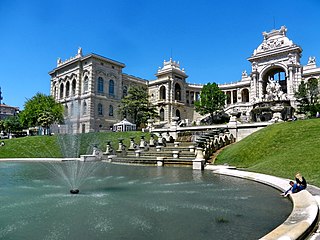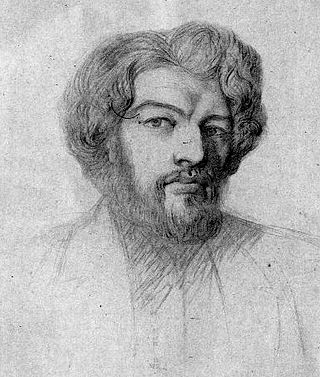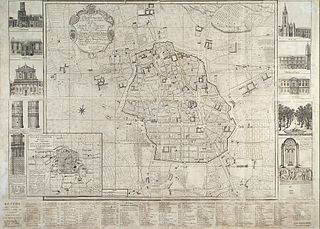History
The first courthouse was built between 1743 and 1747 in the old town, on Place Daviel, opposite the église des Accoules. [1] In the building known as Hôtel Daviel is currently found the local office of the mayor. At the beginning of the 19th century, the location of the Hôtel Daviel was found to be insufficient for the task, and La Coste proposed in 1839 to the General Council that a reconstruction project was put in place for the old palace.
After some discussion, the decision was made to transfer the courthouse to Place Montyon. The council approved this plan on 15, [2] and the foundations were laid in the city of Marseille. The architect was M. Auguste Martin. The inauguration took place on 4 and the bishop of Marseille, Mgr Patrice Cruice, celebrated a mass in one of the meeting rooms. M. Mourier, Imperial Procurer, pronounced the building open at the inaugural meeting, led by Edouard Luce, President of Civil Tribunal.
Further renovation works were launched at the beginning of 2013, [3] and it was closed to the public, and operations were moved to the caserne du Muy, before reopening in 2015.
Exterior
The neoclassical building is 57 metres long, and 54 metres high, in line with most Courthouses built during the Second Empire. The main facade faces onto Place Montyon, named after Jean-Baptiste de Montyon, intendant of Provence in the 18th century. At the centre of this façade is a monumental door made of a stoop of 25 steps, a peristyle of Ionic order of six columns topped with a triangular front on which is a representation of Justice with its right to Force and the defeat of Crime represented by the head of a man to the left of Prudence and Innocence. This group was sculpted by Guillaume. The same sculptor also made two bas reliefs placed under the porch representing repressive justice and protecting justice. The rear façade, on rue Grignan, is less decorated, with only sculptures on the front of the Napoleonic armies and two lions on a commemorative table, all sculpted by Émile Aldebert. Two statues by Joseph Marius Ramus occupy the corners of the peristyle and represent Force and Prudence. The front of the side façades were created by Pierre Travaux ; they represent the East on the side of rue Breteuil, Closure and Moderation, and on the West side, on rue Émile Pollak, Vigilance and Wisdom.
Interior
The main chamber is 16 metres long; it has 16 red Languedoc marble columns supporting a higher gallery on the first floor. The archway consists of 4 sides, divided into 5 coffers, with 4 smaller in the centre. The large coffers each represent a legislator, while each of the smaller coffers represent juridical figures who worked at the time of that legislator. The portraits are:
On the arches are also figures representing the qualities required for magistrates: force, equity, reason, rights, liberty, authority, truth, and eloquence. All the decoration of the archways is by François Gilbert.

The Abbey of Saint-Victor is a former abbey that was founded during the late Roman period in Marseille in the south of France, named after the local soldier saint and martyr, Victor of Marseilles.
Canton of Marseille-La Blancarde is a former canton located within the commune of Marseille in the Bouches-du-Rhône department of France. It was created 27 February 2003 by the decree 2003-156 of that date. It was disbanded following the French canton reorganisation which came into effect in March 2015. Its population was 32,665 in 2012.

The Muséum d’histoire naturel de Marseille, also known in English as the Natural History Museum of Marseille, is one of the most visited natural history museums in France. It was founded in 1819 by Jean-Baptiste, marquis de Montgrand and Christophe de Villeneuve-Bargemon, prefect of the Bouches-du-Rhône department. It is located in the Palais Longchamp, 4th arrondissement of Marseille, built according to the plans of Henri-Jacques Espérandieu.

La Vieille Charité is a former almshouse, now functioning as a museum and cultural centre, situated in the heart of the old Panier quarter of Marseille in the south of France. Constructed between 1671, and 1749, in the Baroque style to the designs of the architect Pierre Puget, it comprises four ranges of arcaded galleries in three storeys surrounding a space with a central chapel surmounted by an ovoid dome.

Dominique Louis Féréol Papety was a French painter. He is best known for his canvases and drawings on Greek themes, both Classical and contemporary, and is considered an early member of the Neo-Grec movement.

Don Honoré Armand de Villars, 2nd Duke of Villars, Duke and Peer of France, Prince of Martigues, Grandee of Spain, Knight of the Golden Fleece, Viscount of Melun, Marquis of la Melle, Count of Rochemiley, was a French nobleman, soldier and politician.

André-Joseph Allar was a French sculptor.

The quartier Mazarin is a district in the centre of Aix-en-Provence, directly to the south of the cours Mirabeau, the principal boulevard in Aix. On the initiative of Archbishop Michel Mazarin, brother of the Cardinal Jules Mazarin and Archbishop of Aix from 1645-8 and later himself a cardinal, city plans were devised in 1646 by Jean Lombard, director of public works, to extend the city ramparts to the south, incorporating land owned by the Archbishopric of Aix and by the Order of Saint-Jean-de-Malte. Following a grid plan of streets, the quartier contains a large number of hôtels particuliers originally built for the nobility and wealthy merchant class.
François Carli was a French sculptor.

The Église Saint-Théodore is a Roman Catholic church in Marseille, France.

The Église Saint-Joseph is a Roman Catholic church in Marseille.
Georges Vallon (1688-1767) was a French architect. Many of his buildings are listed as "monuments historiques".
Antoine Aude (1799–1870) was a French lawyer and politician. He served as the Mayor of Aix-en-Provence from 1835 to 1848.

Boulevard Chave is a major boulevard in Marseille, Bouches-du-Rhône, France. Built in 1842 and named in honor of landowner André Chave, it has had a tramline since 1892.

The Hôtel d'Esmivy de Moissac is a listed hôtel particulier in Aix-en-Provence, Bouches-du-Rhône, France.

The Place Jean-Jaurès, a.k.a. La Plaine, is a historic square in Marseille, Bouches-du-Rhône, Provence-Alpes-Côte d'Azur, France. As early as the 13th century, it was a camping ground for Christian Crusaders on their way to the Holy Land. It later became a meeting place to welcome dignitaries and members of the French royal family. It is now home to a farmers' market. It is named after politician Jean Jaurès.

Auguste André Coussillan was a French historian specialising in the history of Paris. Under the pen-name Jacques Hillairet he wrote two major reference works on the subject in the 1950s - Connaissance du vieux Paris and Dictionnaire historique des rues de Paris.

Joseph Girard was a French historian, librarian and museum curator. He was born and died in Avignon, where an avenue is named after him.

Rue Beaujolais is a street in the 1st arrondissement of Paris, France.

The Arsenal des Galères is a former military arsenal located in Marseille, France. It was built by Colbert in the second half of the 17th century to house and arm King Louis XIV's galleys, but was only fully operational for less than a hundred years, galleys rapidly losing their role in naval warfare to ships.

















